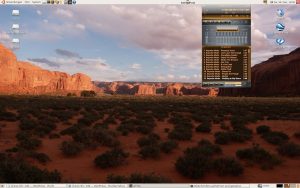Installing "Edgy" HOWTO
Ubuntu is a fine and easy to install Linux distro but of course it doesn’t lack some small bugs or other little issues, but they are easy to overcome - if you know how… I thought I’d sum it all up in one little install HOWTO. (Please keep in mind: this is the way I got it working for my amd64 system…) Here we go!
- Download the “alternate” iso (in my case “ubuntu-6.10-alternate-amd64.iso”) from here.
- Check md5 sum of the iso file (for Windows: get md5summer from here, Linux: simply type
md5sum <filename>) and compare to original listed in “MD5SUMS” file - Burn iso to CD and prepare BIOS to boot from it and finally: boot from it!
- Highlight “Install in text mode”
- If you need to pass any extra options to the kernel press “F6” at the start screen and add them to the line of options. In my case I have to add “noapic”. Then press “Enter”.
- Follow the on screen instructions. You have to answer some simple questions about preferred language, keyboard layout and computer name. Use the arrow keys to move around and “Enter” to select. If you’re connected to the Internet via DSL router everything works out of the box. You may have to specify IP, netmask and gateway if no DHCP server is activated on your router, but that’s all. I have no idea how to configure the network if you’re using ISDN or PPPoE, but you may find something about it here.
- When it comes to partitioning I’d choose the manual way. You need at least two partitions:
swapand the/file system. I’d recommend an extra filesystem for/home. I don’t know if it’s necessary but myswappartition is 2 GB,/about 35 GB and/home25 GB. As filesystem choose “ext3”. By default Ubuntu mounts every existing partition under/media/<device>where “device” may be “sda1” for example. It’s possible, but I wouldn’t mount any NTFS partitions as write support is still a bit flaky. So highlight any NTFS partition, press “Enter”, then select “Use as”, press “Enter” and finally choose “don’t use”. For existing fat32 partitions you may select other mount points. Again, highlight the partition, select “mount point” and then edit it manually. It’s a good idea to keep the/media-part and then add something like “windows”. There will be a final warning concerning formatting, choose “yes” and wait a few seconds/minutes. - In the next step your user account will be created. Just add full name, user name and password.
- Now files are being copied - time to relax ;-) If you have a working Internet connection answer “yes” to the question whether to download language support files.
- The last question is about grub, the boot loader. If you have Windows on one of your partitions the installer should detect and it to grub. If you have other Linux distros installed be careful not to overwrite your current boot sector. However, usually it should be OK to write grub to the master boot record (MBR), so answer “yes” here.
- Time to reboot! The CD will be ejected automatically and the system will reboot.
- Nothing to do if you don’t need extra kernel options to make Ubuntu boot, continue with step 15. If you have the need for extra options you have to add them now manually at the grub start screen. Sadly, the installer doesn’t remember them and won’t add them automatically. So highlight the new Ubuntu entry and press “e” to edit. Then highlight the line which should look something like this:
/boot/vmlinuz-2.6.XX-XX-generic root=/dev/sda2 ro quiet splash
Press “e” again and add the appropriate option to the end of the line, in my case again noapic.
- Press “Enter” again an then “b” to boot this entry.
- Once Ubuntu booted up fine, open a terminal and type (password is that of your user)
1
$ sudo gedit /boot/grub/menu.lst
Search for the two lines
# defoptions=quiet splash
and
# altoptions=(recovery mode) single
Do not delete the leading # and add noapic to the end of those lines. This way, every time there is a kernel update, your kernel option will be added automatically to the grub configuration file. If you don’t want to update your new Ubuntu installation right now (not recommended!) which would add the new entry because the kernel will be updated, you need to search for /boot/vmlinuz-2.6.XX-XX-generic root=/dev/sda2 ro quiet splash and add it to the end of the line, too.
- So far, so good. Now the next thing is to update. There should be a blinking icon at the top right which indicates that updates are available. As I don’t like updating essentials like xorg while it is running, I wouldn’t use this feature to make the first big update. So, close all programs, open a terminal and type:
1
$ sudo /etc/init.d/gdm stop
This will stop all X and you drop down to console. If there’s no login prompt use “Alt” + “F1-8” to change the terminal, login and type
1
2
$ sudo apt-get update
$ sudo apt-get dist-upgrade
When everything is done, reboot with
1
$ sudo shutdown -r now
- The next thing is to customize Ubuntu, install additional software (like nVidia drivers) and so on… That’ll follow soon as another HOWTO!
